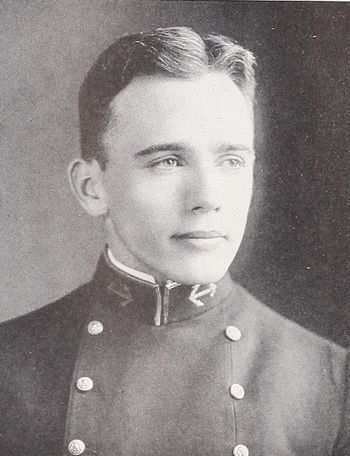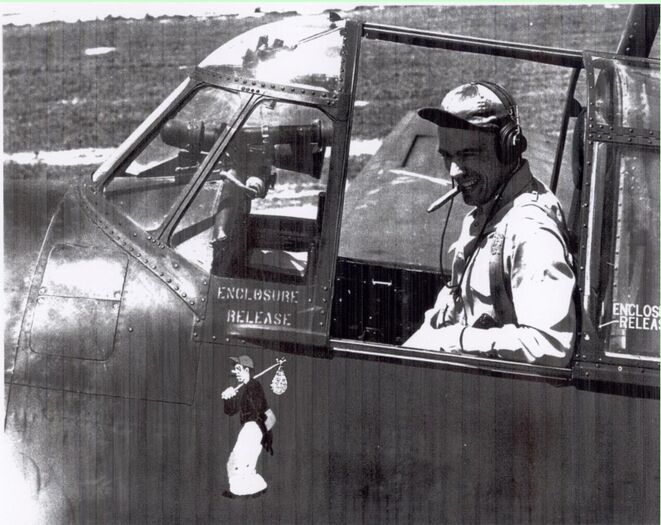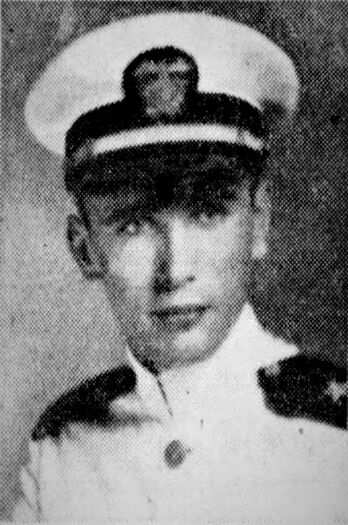FRANK M. WHITAKER, LCDR, USN
Frank Whitaker '34
Lucky Bag
From the 1934 Lucky Bag:
FRANK MELVIN WHITAKER
Spokane, Washington
"Whit" "Francois"
WHILE busily engaged building models of old-time ships, great square-rigged sailing vessels which played so prominent a part in our early history, "Whit" became conscious of a desire to become a part of that life. It was his ambition to become attached to a man-o'-war, to visit far-off ports, and to view strange lands. Opportunity offered itself in the way of an appointment during a course of study at Gonzaga University, and it wasn't long before Frank was wrestling with the academic department, amid supplications to Tecumseh, and he successfully repulsed all attacks.
His organizing ability found an outlet in the many committees with which he was invariably associated. Not content with keeping Frank on the jump only at infrequent intervals, the authorities that be decreed that he should jump considerably higher and consequently elected him chairman of the Farewell Ball. His many sketches and illustrations so frequently appearing in the Trident show, undeniably, his artistic talents.
Having obtained considerable training in his early striding over the mountains in and about Spokane, Frank took naturally to hurdling when he went out for track, the hurdles resembling obstacles in his pathway through the mountain fastnesses. Although occupied in various other sports throughout the year, it is on the track that he is most at home, and where he has attained considerable success. Frank has been an admirable companion, a true "wife" and a pal with whom it has been a pleasure to associate. Happy cruise, "Whit."
Co. Rifle Team 3, 2, 1. 2 P.O.

FRANK MELVIN WHITAKER
Spokane, Washington
"Whit" "Francois"
WHILE busily engaged building models of old-time ships, great square-rigged sailing vessels which played so prominent a part in our early history, "Whit" became conscious of a desire to become a part of that life. It was his ambition to become attached to a man-o'-war, to visit far-off ports, and to view strange lands. Opportunity offered itself in the way of an appointment during a course of study at Gonzaga University, and it wasn't long before Frank was wrestling with the academic department, amid supplications to Tecumseh, and he successfully repulsed all attacks.
His organizing ability found an outlet in the many committees with which he was invariably associated. Not content with keeping Frank on the jump only at infrequent intervals, the authorities that be decreed that he should jump considerably higher and consequently elected him chairman of the Farewell Ball. His many sketches and illustrations so frequently appearing in the Trident show, undeniably, his artistic talents.
Having obtained considerable training in his early striding over the mountains in and about Spokane, Frank took naturally to hurdling when he went out for track, the hurdles resembling obstacles in his pathway through the mountain fastnesses. Although occupied in various other sports throughout the year, it is on the track that he is most at home, and where he has attained considerable success. Frank has been an admirable companion, a true "wife" and a pal with whom it has been a pleasure to associate. Happy cruise, "Whit."
Co. Rifle Team 3, 2, 1. 2 P.O.
Loss
Frank was lost in a mid-air collision over Engebi Island on February 2, 1944, while operating from USS Bunker Hill (CV 17) as Commanding Officer of Torpedo Squadron (VT) 17. This was a part of the Battle of Eniwetok.
Other Information
From researcher Kathy Franz:
Frank attended Garfield grade school and graduated from Gonzaga high school. He was in his sophomore year at Gonzaga university when he received an appointment to the Naval Academy from Representative Quayle of Brooklyn, New York. His high school yearbook in 1945 was dedicated to him and others who gave their lives in the service.
His father was Fred, mother Marguerite, brother Stanley, and sisters Mary and Ellen.
The Spokesman-Review, Spokane, Washington, March 2, 1944:
Fame Came to Com. Whitaker
Lieutenant Commander Frank M. Whitaker, native of Spokane, had flown on 22 combat missions in the Pacific before he met death in the Marshall Islands operations early in February. On these several missions he displayed such skill and daring and achieved results so important that he twice was recommended for the distinguished flying cross, the navy cross, the silver star medal and the air medal for action at Namur.
These and many other facts of his brilliant navy record were recorded in a remarkable tribute to him and his leadership in the ship’s paper published aboard the carrier of which he was senior flight commander, copies of which have been received by his parents, Dr. and Mrs. Fred J. Whitaker, E128 Twelfth avenue, long-time residents of Spokane and members of pioneer northwest families.
Reviewing his career and testifying to the affection he inspired in the members of his squadron and all associated with him on the carrier, the ship’s paper said in part:
Paper Pays Fine Tribute.
“The tragic death of Lieutenant Commander Frank M. Whitaker not only robbed the ship, the air group and the squadron of a great leader, but also cut short a career destined to be one of the most brilliant in aviation.
“It may seem biased to say that he revolutionized torpedo bombing tactics, but the fact remains, the principles that he worked out and applied so successfully are bound to influence the future of naval aviation. The nuances and dodges he developed in rhythmic perfection on evasive tactics will be the means of many a safe return for a pilot from a mission. He was not only a pioneer on skip bombing tactics, but one of its most enthusiastic supporters. To him goes the credit for leading the first masthead attack from a carrier, and its success can well be its upholder.
“Of all the combat missions in which he participated – he made 22 off this ship, almost every one resulting in a direct hit on an important target – two stood out most prominently in his mind. One was a direct hit scored on a heavy coastal battery, the last gun firing during an attack on a Jap base, which he silenced forever with a perfect drop of a blockbuster. The other was his landing at a captured airfield. He probably wrought more devastating destruction to Jap shipping and important shore installations than any pilot aboard.
“An Aviator’s Aviator.”
“He was an aviator’s aviator, equipped with all the knowledge and skill that make a good combat pilot. Few could fly with him. None could surpass him. His unbounded confidence in himself and his plane was infectious. It inspired every officer and man in his torpedo squadron to excel himself in an effort to emulate the ‘skipper.’
“He took a group of pilots, largely inexperienced and a bunch of average American men and welded them into one of the most efficient fighting units our navy has ever known. They have left their mark on the enemy, and in tribute to the ‘skipper’ they will continue to hit them, and hit them hard, at every opportunity.”
Columnist Raymond Clapper also died in Frank’s plane.
His wife was listed as next of kin.
Photographs
Obituary
From Together We Served:
THE FIRST SKIPPER - FRANK M. WHITAKER
Frank M. Whitaker was born in 1910 at Spokane, Washington. His family had settled there in 1876, his father a physician and grandfather a farmer near Pullman. Frank was an accomplished artist and musician in high school, where he played football and turned out for track. In 1927, on the day Lindbergh flew the Atlantic, Frank won the state 220 low hurdles championship.
Frank attended Gonzaga University in Spokane before winning an appointment to the Naval Academy in 1930, where he continued to participate in sports, music and art.
After graduation in 1934, he served nine months aboard the USS MARYLAND (BB-46), followed by two years aboard USS CROWNINSHIELD (DD-134), an old four-pipe destroyer later turned over to Britain as part of the lend-lease program.
The Class of 1934 was full of over-achievers. One reason was the congressional mandate that only the upper half of each class receive a Navy Commission. The others entered the Reserve and waited for an opening. President Roosevelt’s expansion of the Navy created a new demand for officers, so all of the 1934 and subsequent classes were commissioned.
Frank applied for flight training and reported to Pensacola in January 1937. Fourteen months later, Frank was assigned to Torpedo Six (VT-6), LCDR W. B. Ault commanding. VT-6 received 18 new TBD Devastators between February and April 1938 and then deployed on the USS ENTERPRISE (CV-6) shakedown cruise to Rio de Janeiro (18 July to 22 September 1938).
Frank was detailed to fly the cameraman and director of the MGM feature film “Flight Command.” Following this 3-month stint, Frank reported for duty in Pensacola with Training Squadron 1-B. This was followed by a brief tour as XO of a squadron assigned to USS Bogue before assuming command of VT-17. The film “Flight Command” was released in 1940, starring Robert Taylor as a new ensign, Walter Pidgeon as the skipper and Ruth Hussey as the skipper’s wife. The aerial scenes were flown by real Navy pilots from a squadron based at San Diego at the time.
Training Squadron VN-1B was based at Corry Field, one of 16 bases then flying the bi-wing N2S/N3N Yellow Peril. This was Primary flight training lasting about three months, beginning with taxiing the tail-dragger aircraft and ending with formation and night flying. Each student accumulated about 110-hours of flying, dual and solo, plus a couple hundred hours of class-room instruction. Frank probably instructed at Corry from the summer of 1940 until the summer of 1942.
In June of 1942, VGS-9 (later VC-9) was in Kodiak flying F4Fs. In July, the squadron moved to NAS Seattle. In September, the squadron had 6 F4Fs and 4 TBFs. The squadron moved to San Pedro in October and then to San Diego in November, at which time the squadron had their full complement of 12 F4F and 9 TBF aircraft, commanded by LCDR William B. Drane. USS BOGUE (ACV-9 later CVE-9) arrived in San Diego near the end of November. By mid-December, the ship and squadron were reported “at sea” and arrived in Norfolk on New Year’s Day. The exact dates of Frank’s service with this squadron are unknown.
VT-17 was officially commissioned on 1 January 1943, LCDR Frank M. Whitaker commanding. However, the squadron had only 13 aircraft by the end of February, with new pilots and aircraft dribbling in over the next few weeks.
The other skippers in Air Group Seventeen (CVG-17) were LCDR John Thomas Blackburn 1 (NA 1933) the skipper of VF-17, and LCDR James E. Vose 2 (NA 1934) the skipper of VB-17. The Air Group Commander (CAG) was CDR Michael P. Bagdanovich (NA 1929). According to Blackburn, Frank was known as the Silver Fox in those days, probably because of his premature gray hair.
The air group boarded USS BUNKER HILL in July 1943. Frank and his 1st division became known as “Hobo.” The 2nd division became “Boxcar”; and the 3rd division became “Caboose.” Their home aboard BUNKER HILL became “Hobotown.” “Roundhouse” was the call for pilots to rendezvous. “Chow Down” was the signal to prepare to attack and “Dinner is ready” signaled the target is sighted.
Frank had met Mary Lewellin during his tours in San Diego and they married in June 1937. The couple raised two children, Frank III and Margaret, who were 6 and 3 at the time of Frank’s tragic death. Frank and his wingman had a mid-air collision on 2 February 1944, near Engebi Island in the Eniwetok Atoll. There are few details on exactly how the collision occurred, but witnesses saw both aircraft hit the water and the area was thoroughly searched for survivors without success.
Remembrances
At Torpedo Squadron 17 there is a full history of the squadron, which was established with Frank as the first Commanding Officer. "According to Tom Blackburn, skipper of VF-17, LCDR Whitaker "begged, borrowed, or stole several airborne radars, which he used to develop foul-weather and night-attack techniques that eventually won fleetwide acceptance in early 1944"."
A day-by-day history of the squadron is also available at Fist History. "VT-17 Commanding Officer, LCDR WHITAKER, was killed in a mid-air collision over Engebi Island. His wingman, LTJG ED STACK, was also killed along with their six crewmen. The Washington columnist RAYMOND CLAPPER, riding in Whitaker's aircraft, was also killed."
Distinguished Flying Cross
From Hall of Valor:
The President of the United States of America takes pride in presenting the Distinguished Flying Cross (Posthumously) to Lieutenant Commander Frank Melvin Whitaker (NSN: 0-73547), United States Navy, for extraordinary achievement while participating in aerial flight while leading his torpedo squadron in a daring attack on Japanese forces at Rabaul, on 11 November 1943. Lieutenant Commander Whitaker aided in the sinking of a destroyer and a cruiser, the probable destruction of another cruiser, and the severe damaging of two other combatant vessels.
General Orders: Bureau of Naval Personnel Information Bulletin No. 329 (August 1944)
Action Date: November 11, 1943
Service: Navy
Rank: Lieutenant Commander
Company: Torpedo Squadron 17 (VT-17)
From Hall of Valor:
The President of the United States of America takes pride in presenting a Gold Star in lieu of a Second Award of the Distinguished Flying Cross (Posthumously) to Lieutenant Commander Frank Melvin Whitaker (NSN: 0-73547), United States Navy, for extraordinary achievement while participating in aerial flight while commanding Torpedo Squadron SEVENTEEN (VT-17) in the New Ireland area from 25 December 1943 to 5 January 1944. Lieutenant Commander Whitaker led his squadron against Japanese vessels in Kavieng Harbor in the face of persistent anti-aircraft fire and intense fighter opposition. His squadron destroyed two large cargo vessels, one destroyer and three barges and severely damaged two cruisers, four destroyers, several small cargo ships, numerous barges and one torpedo boat.
General Orders: Bureau of Naval Personnel Information Bulletin No. 329 (August 1944) Action Date: December 25, 1943 - January 5, 1944
Service: Navy
Rank: Lieutenant Commander
Company: Torpedo Squadron 17 (VT-17)
From Hall of Valor:
The President of the United States of America takes pride in presenting a Second Gold Star in lieu of a Third Award of the Distinguished Flying Cross (Posthumously) to Lieutenant Commander Frank Melvin Whitaker (NSN: 0-73547), United States Navy, for extraordinary achievement while participating in aerial flight as Commanding Officer of Torpedo Squadron SEVENTEEN (VT-17) in the Marshall Islands area from 29 January to 2 February 1944. Lieutenant Commander Whitaker led his squadron on two pre-dawn glide bombing attacks, without fighter escort, against enemy air installations at Kwajalein and Engebi. Despite devastating anti-aircraft fire, his squadron so damaged the airfields that they were useless to the enemy. On a second assault the same day he attacked and sank a merchant vessel.
General Orders: Bureau of Naval Personnel Information Bulletin No. 331 (October 1944)
Action Date: January 29 - February 2, 1944
Service: Navy
Rank: Lieutenant Commander
Company: Torpedo Squadron 17 (VT-17)
The "Register of Commissioned and Warrant Officers of the United States Navy and Marine Corps" was published annually from 1815 through at least the 1970s; it provided rank, command or station, and occasionally billet until the beginning of World War II when command/station was no longer included. Scanned copies were reviewed and data entered from the mid-1840s through 1922, when more-frequent Navy Directories were available.
The Navy Directory was a publication that provided information on the command, billet, and rank of every active and retired naval officer. Single editions have been found online from January 1915 and March 1918, and then from three to six editions per year from 1923 through 1940; the final edition is from April 1941.
The entries in both series of documents are sometimes cryptic and confusing. They are often inconsistent, even within an edition, with the name of commands; this is especially true for aviation squadrons in the 1920s and early 1930s.
Alumni listed at the same command may or may not have had significant interactions; they could have shared a stateroom or workspace, stood many hours of watch together, or, especially at the larger commands, they might not have known each other at all. The information provides the opportunity to draw connections that are otherwise invisible, though, and gives a fuller view of the professional experiences of these alumni in Memorial Hall.
July 1934
October 1934
January 1935
April 1935
October 1935
January 1936
April 1936
July 1936
January 1937
LT John Duke '26
CAPT Ernest Pollock '28
LTjg William Pennewill '29
LTjg Gilbert Carpenter '30
LTjg Lance Massey '30
LTjg William Sisko '31
1LT Harold Larson '31
LTjg Charles Crommelin '31
ENS Harold Von Weller '33
April 1937
CAPT Ernest Pollock '28
LTjg William Pennewill '29
LTjg Gilbert Carpenter '30
LTjg Lance Massey '30
1LT Harold Larson '31
LTjg Charles Crommelin '31
ENS Harold Von Weller '33
September 1937
CAPT Paul Moret '30
LTjg Samuel Dealey '30
1LT Harold Larson '31
LTjg Albert Gray '31
LTjg Charles Crommelin '31
LTjg John Spiers '32
LTjg John Phillips, Jr. '33
CAPT Ernest Pollock '28 (Training Squadron (VN) 2D8)
LT William Pennewill '29 (Training Squadron (VN) 1D8)
January 1938
CAPT Paul Moret '30
LTjg Samuel Dealey '30
1LT Harold Larson '31
LTjg Albert Gray '31
LTjg Charles Crommelin '31
LTjg John Spiers '32
LTjg John Phillips, Jr. '33
LTjg Robert Isely '33
CAPT Ernest Pollock '28 (Training Squadron (VN) 2D8)
LTjg Alden Irons '31 (Training Squadron (VN) 2D8)
July 1938
LT Bruce Van Voorhis '29 (Scouting Squadron (VS) 6)
LT Gilbert Carpenter '30 (USS Enterprise)
LTjg Walker Ethridge '34 (Bombing Squadron (VB) 6)
LTjg James Tyler '34 (Scouting Squadron (VS) 6)
ENS Webster Johnson '36 (USS Enterprise)
ENS Bruce Skidmore '37 (USS Enterprise)
ENS Ernest Wood, Jr. '38 (USS Enterprise)
January 1939
LT Bruce Van Voorhis '29 (Scouting Squadron (VS) 6)
LT Gilbert Carpenter '30 (USS Enterprise)
LTjg Walker Ethridge '34 (Bombing Squadron (VB) 6)
ENS Webster Johnson '36 (USS Enterprise)
ENS Bruce Skidmore '37 (USS Enterprise)
ENS Ernest Wood, Jr. '38 (USS Enterprise)
October 1939
LT Alfred Tucker, III '31 (USS Enterprise)
LTjg Walker Ethridge '34 (Bombing Squadron (VB) 6)
LTjg Philip Torrey, Jr. '34 (Bombing Squadron (VB) 6)
ENS Bruce Skidmore '37 (USS Enterprise)
ENS Ernest Wood, Jr. '38 (USS Enterprise)
ENS Lester Wall, Jr. '39 (USS Enterprise)
June 1940
LT Ralph Smith '26 (Scouting Squadron (VS) 6)
LT Edward Allen '31 (Scouting Squadron (VS) 6)
LT Alfred Tucker, III '31 (USS Enterprise)
LTjg Walker Ethridge '34 (Bombing Squadron (VB) 6)
LTjg Hubert Harden '35 (Scouting Squadron (VS) 6)
ENS Ernest Wood, Jr. '38 (USS Enterprise)
ENS Edward Degarmo '40 (USS Enterprise)
November 1940
CDR William Sample '19
LT William Pennewill '29
LT Finley Hall '29
LT John Yoho '29
LT Lance Massey '30
LT George Bellinger '32
LT Martin Koivisto '32
LT John Spiers '32
LT Daniel Gothie '32
LT Dewitt Shumway '32
LT Albert Major, Jr. '32
LTjg John Phillips, Jr. '33
ENS Frank Peterson '33
LTjg Charles Brewer '34
LTjg Walker Ethridge '34
CAPT Floyd Parks '34
LTjg Charles Ware '34
LTjg Philip Torrey, Jr. '34
LTjg George Nicol '34
LTjg Victor Gadrow '35
LTjg John Powers '35
LTjg Allan Edmands '35
LTjg Roy Krogh '36
LTjg Porter Maxwell '36
LTjg Richard Hughes '37
LTjg Frank Henderson, Jr. '37
LTjg John Thomas '37
LTjg John Boal '37
ENS Harry Howell '38
ENS Eric Allen, Jr. '38
ENS James Ginn '38
ENS Oswald Zink '38
ENS Frank Case, Jr. '38
ENS Howard Fischer '38
ENS Edmundo Gandia '38
ENS Charles Reimann '38
ENS Howard Clark '38
ENS Roy Hale, Jr. '38
ENS Leonard Thornhill '38
ENS Osborne Wiseman '38
ENS John Eversole '38
ENS Jep Jonson '38
ENS Roy Green, Jr. '38
ENS Marion Dufilho '38
2LT James Owens '38
ENS William Brady '38
ENS Charles Anderson '38
ENS Carl Holmstrom '38
ENS Charles King '38
2LT John Maclaughlin, Jr. '38
ENS William Tate, Jr. '38
2LT Douglas Keeler '38
ENS Harry Bass '38
ENS John Kelley '38
ENS John Erickson '38
ENS William Lamberson '38
ENS Donald Smith '38
ENS Frank Quady '38
ENS Richard Crommelin '38
ENS Robert Seibels, Jr. '38
ENS Alphonse Minvielle '38
April 1941
LT William Pennewill '29
LT Finley Hall '29
LT John Yoho '29
LT William Sisko '31
LT George Bellinger '32
LT Martin Koivisto '32
LT John Spiers '32
LT Archibald Greenlee '32
LT Daniel Gothie '32
LT Albert Major, Jr. '32
LTjg John McCormack, Jr. '33

The "category" links below lead to lists of related Honorees; use them to explore further the service and sacrifice of alumni in Memorial Hall.

